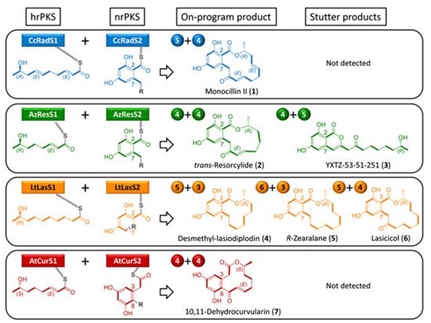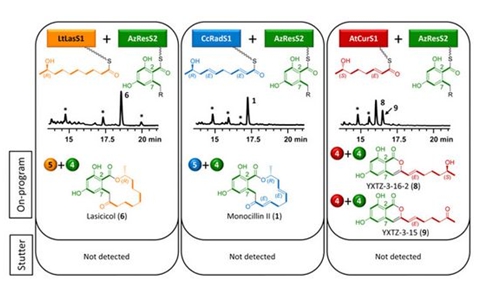分享到
Sino-US scientists made a breakthrough in combinatorial biosynthesis of fungal polyketides
The research article, Diversity-oriented Combinatorial Biosynthesis of Benzenediol Lactone Scaffolds by Subunit Shuffling of Fungal Polyketide Synthases, was published online on July 22 in PNAS (Proceedings of the National Academy of the Sciences of the United States of America). It provides a new strategy and new approach to broaden bioactive molecules for pharmaceutical and agricultural application. This research breakthrough was led by Professor Lin Min at Biotechnology Research Institute (BRI) of Chinese Academy of Agricultural Sciences (CAAS) and Professor Istvan Molnar at University of Arizona, USA. The first author is Professor Xu Yuquan, one of the candidates of the Elite Youth Program of Chinese Academy of Agricultural Sciences.
Fungal polyketides are one of the largest families of structurally diverse secondary metabolites, biosynthesized by multi-domain polyketide synthases. Fungal benzenediol lactone (BDL) polyketides are important pharmacophores with wide-ranging bioactivities, including heat shock response and immune system modulatory effects. Combinatorial biosynthesis promises to generate a novel unexplored source of bioactive molecules in an environmentally sustainable, economical, and inherently scalable manner. Currently, combinatorial biosynthesis of polyketides is still in its infancy.

Fig. 1. Biosynthesis of natural benzenediol lactones

Fig. 2. Combinatorial biosynthesis of polyketides
By Kang Yuli
kongyuli@caas.cn
Fungal polyketides are one of the largest families of structurally diverse secondary metabolites, biosynthesized by multi-domain polyketide synthases. Fungal benzenediol lactone (BDL) polyketides are important pharmacophores with wide-ranging bioactivities, including heat shock response and immune system modulatory effects. Combinatorial biosynthesis promises to generate a novel unexplored source of bioactive molecules in an environmentally sustainable, economical, and inherently scalable manner. Currently, combinatorial biosynthesis of polyketides is still in its infancy.

Fig. 1. Biosynthesis of natural benzenediol lactones

Fig. 2. Combinatorial biosynthesis of polyketides
BDLs are biosynthesized by collaborating polyketide synthase enzyme pairs
in fungi(Fig.1). In this research, scientists coexpressed random heterocombinated the enzymes from different BDL biosynthetic pathways (monocillin II, resorcylide, lasiodiplodin and curvularin) in yeast cells to lead to the one-pot, one-step combinatorial biosynthesis of structurally diverse polyketides in practical amounts (Fig.2).Broadening the medicinally relevant chemical space of polyketides by such methods will provide unnatural products as valuable entry points for drug discovery and development.
Microorganism Functional Genomics Innovation Team of BRI and Natural Products Center of University of Arizona have long-term research cooperation and have made important progress. The relevant research results were published in PNAS (2013 and 2014), ACS Chemical Biology (2014) and AEM (2013).The further cooperation between these two teams will focus on elucidation of the programming biosynthesis mechanism of fungal polyketides, high-throughput screening of non-natural products, and development of new bio-pesticides and high-quality and stress-resistance crop varieties.
More details are available from the links bellow: http://www.pnas.org/content/early/2014/07/16/1406999111.full.pdf+html?sid=e8660378-7015-4004-9ff9-cf7e7752e8b2
in fungi(Fig.1). In this research, scientists coexpressed random heterocombinated the enzymes from different BDL biosynthetic pathways (monocillin II, resorcylide, lasiodiplodin and curvularin) in yeast cells to lead to the one-pot, one-step combinatorial biosynthesis of structurally diverse polyketides in practical amounts (Fig.2).Broadening the medicinally relevant chemical space of polyketides by such methods will provide unnatural products as valuable entry points for drug discovery and development.
Microorganism Functional Genomics Innovation Team of BRI and Natural Products Center of University of Arizona have long-term research cooperation and have made important progress. The relevant research results were published in PNAS (2013 and 2014), ACS Chemical Biology (2014) and AEM (2013).The further cooperation between these two teams will focus on elucidation of the programming biosynthesis mechanism of fungal polyketides, high-throughput screening of non-natural products, and development of new bio-pesticides and high-quality and stress-resistance crop varieties.
More details are available from the links bellow: http://www.pnas.org/content/early/2014/07/16/1406999111.full.pdf+html?sid=e8660378-7015-4004-9ff9-cf7e7752e8b2
By Kang Yuli
kongyuli@caas.cn
Latest News
-
 Apr 18, 2024Opening Ceremony of the Training Workshop on Wheat Head Scab Resistance Breeding and Pest Control in Africa Held in CAAS
Apr 18, 2024Opening Ceremony of the Training Workshop on Wheat Head Scab Resistance Breeding and Pest Control in Africa Held in CAAS -
 Apr 03, 2024IPPCAAS Co-organized the Training Workshop on Management and Application of Biopesticides in Nepal
Apr 03, 2024IPPCAAS Co-organized the Training Workshop on Management and Application of Biopesticides in Nepal -
 Mar 28, 2024Delegation from the School of Agriculture and Food Science of University College Dublin, Ireland Visit to IAS, CAAS
Mar 28, 2024Delegation from the School of Agriculture and Food Science of University College Dublin, Ireland Visit to IAS, CAAS -
 Mar 25, 2024Director of World Food Prize Foundation visited GSCAAS
Mar 25, 2024Director of World Food Prize Foundation visited GSCAAS -
 Mar 20, 2024Institute of Crop Sciences (ICS) and Syngenta Group Global Seeds Advance Collaborative Research in the Seed Industry
Mar 20, 2024Institute of Crop Sciences (ICS) and Syngenta Group Global Seeds Advance Collaborative Research in the Seed Industry
